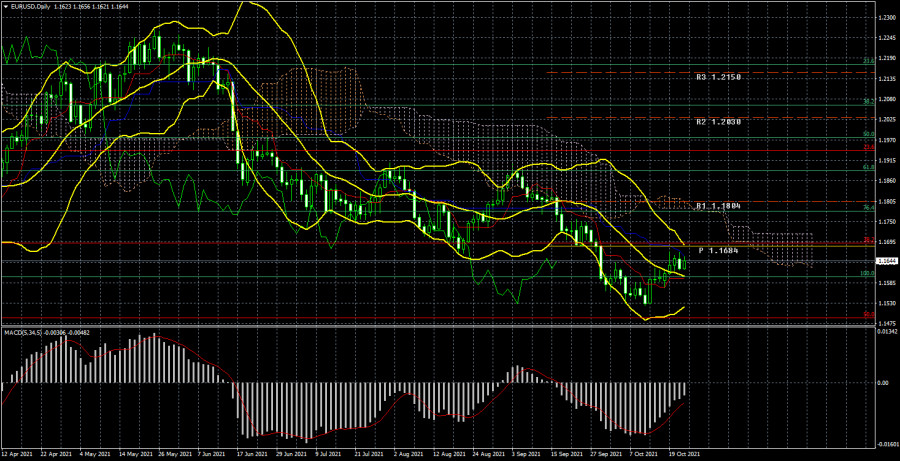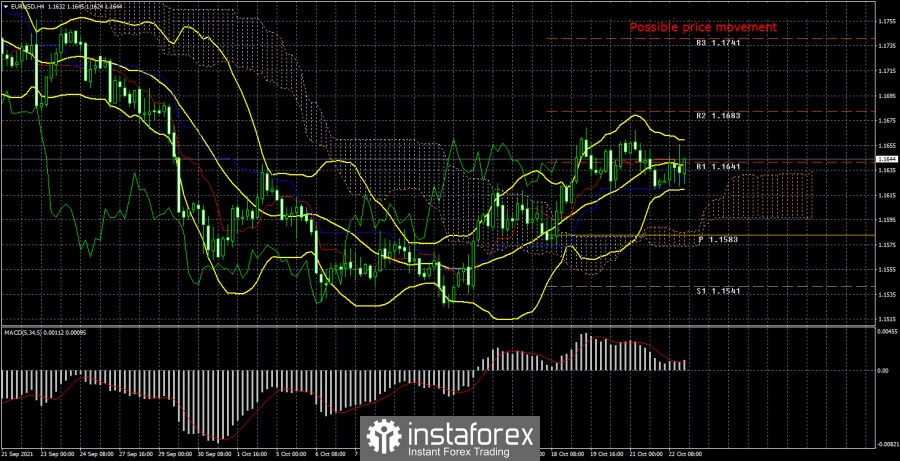
The European currency, paired with the US dollar, continued a very weak correction last week, clearly seen in the illustration above. As we have already said, overcoming the critical Kijun-sen line will play a huge role for the pair. If the bulls manage to lead the pair through this line, then the chances of continuing the upward movement will increase significantly. If not, then the downward movement is highly likely to resume. Recall that in a week and a half, the next meeting of the Fed will take place, at which most traders will again expect the announcement of the beginning of the curtailment of the quantitative stimulus program. Also, recall that, according to about half of the experts, the Fed should have signaled the curtailment of QE back in September. But that didn't happen then. Now, at least half of the experts also expect the QE program to be curtailed. However, this time, everything may end as it is not expected. The Fed can take a break again and not force events, but wait until December, when the last meeting of the regulator will take place this year.
There are quite a lot of reasons for such a development of the event. For example, weak reports on NonFarm Payrolls for the last two months. Recall that the main goal of the Fed is the full recovery of the labor market, and it is for this that the quantitative stimulus program continues to operate. However, this is a double-edged sword. On the one hand, the QE program needs to be extended if the pace of labor market recovery is falling (and they are falling).
On the other hand, the labor market is still recovering, and the QE program will not be completed in one day, week, or month. It will still function in any case until the middle of 2022, as Jerome Powell said. Therefore, the question is, will there be enough time for the labor market to recover to maximum employment levels, considering the QE program until mid-2022 and with the condition of its gradual reduction? It is this question that the Fed will have to answer on November 3.
We once again draw traders' attention to the fact that the two main euro/dollar and pound/dollar pairs are moving differently now, which is quite unusual for them. Thus, it cannot be concluded that American factors have a significant impact on the foreign exchange market. We assume that the euro and the pound have been rising against the dollar recently because the markets are simply tired of waiting for the Fed to announce the end of QE. But at the same time, for the euro/dollar pair, we are now talking about a banal correction against a downward trend, and for the pound/dollar pair, about a stronger upward movement of quotes. It also falls under the concept of "correction," but the movement is much stronger and can be the beginning of a new upward trend.
What should traders expect next week? As we have already said, macroeconomic statistics now rarely have an impact on the course of trading. In principle, given the volatility of the euro/dollar pair, it is generally difficult to say what influences its movement. Nevertheless, important macroeconomic and fundamental events should not be overlooked. Moreover, the ECB meeting will be held next week, which is always important and interesting. Actually, until Thursday, when the meeting results will be summed up, nothing interesting will happen in the European Union. And there is nothing special to expect from the meeting of the European central bank now. The key rate will remain unchanged with a 100% probability. Thus, again, everything will depend on what Christine Lagarde will say at the press conference and the rhetoric regarding the PEPP program. Recall that the PEPP program is the same QE program. At the last meeting, Lagarde already stated that its volumes would decrease in the last two quarters of 2021. Thus, the ECB has already begun to curtail the stimulus. If this process develops, then the euro may receive additional market support.
Also, on Friday, a report on GDP for the third quarter in the European Union will be published. Recall that this report comes out in at least three grades, but the first and last have the highest priority. According to experts, GDP in the third quarter will increase by 2%, which is very small compared to American GDP. On Friday, a report on inflation for October will also be published, which may accelerate from 3.4% y/y to 3.6-3.7% y/y. In principle, there will be nothing surprising in this, since inflation is now rising in many world countries. Nevertheless, these two reports may have a strong impact on the movement of the euro/dollar pair during the week.

Trading recommendations for the EUR/USD pair:
The technical picture of the EUR/USD pair on the 4-hour chart is very clear. The pair is trying to form a new upward trend, but it has stopped moving up in the last two trading days and is now located just above the critical line. Thus, if traders manage to keep the pair above the Kijun-sen line, then purchases will remain relevant with targets scattered up to the level of 1.1750. Given the weak volatility, even this goal may be too far away, despite the strong macroeconomic and fundamental background next week. If the price is fixed back below the critical line and an outright flat does not begin, we advise you to sell the pair again with targets near the level of 1.1490.
Explanations to the illustrations:
Price levels of support and resistance (resistance /support), Fibonacci levels - target levels when opening purchases or sales. Take Profit levels can be placed near them.
Ichimoku indicators(standard settings), Bollinger Bands(standard settings), MACD(5, 34, 5).
The material has been provided by InstaForex Company - www.instaforex.comfrom RobotFX















 Download NOW!
Download NOW!
No comments:
Post a Comment